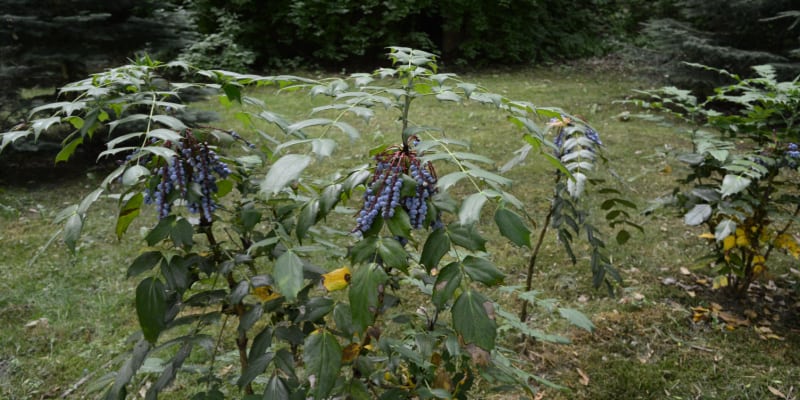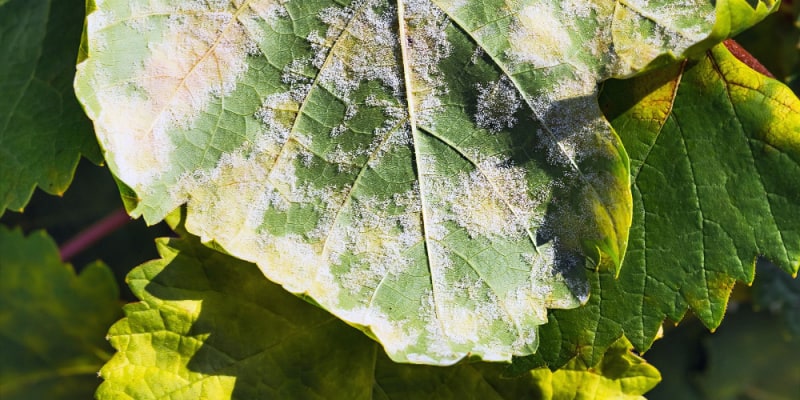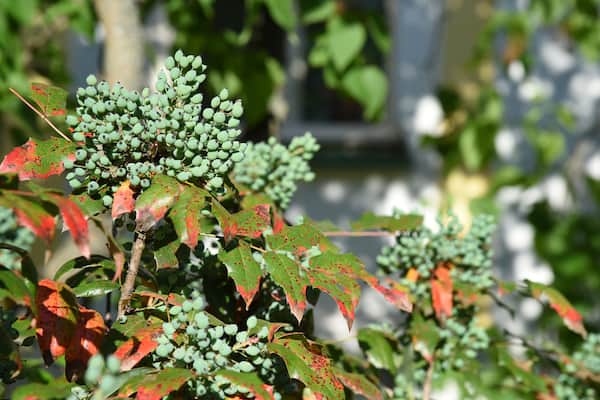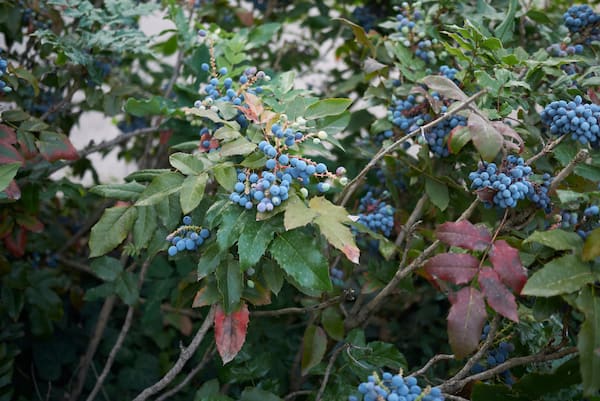
Why has my mahonia got brown spots?
Our site is reader supported, this means we may earn a small commission from Amazon and other affiliates when you buy through links on our site.
The two most common reasons that your mahonia has brown spots are water stress and fungal disease. A third reason may be sunburn, or leaf scorch as it’s known in the plant world. Read on to find out about these problems and what to do about them. The most common is probably the disease rust which is brown spores on the leaves or powdery mildew but this is usually white.
Diseases thats cause brown spots on mahonia leaves
Two diseases create brown spots on your mahonia plant – powdery mildew and rust.
Powdery mildew on mahonia leaves
Powdery mildew is a fungal disease that affects many plants. It prefers environments that have high humidity at night, low humidity during the day and temperatures around 21˚C to 27˚C. It causes brown spots on the leaves and a grey powder on the leaf’s underside. Look also on the stems of your mahonia for signs of this disease.
While is doesn’t look pleasant, powdery mildew isn’t fatal to the mahonia. But it does weaken the plant by taking out important nutrients, causing the leaves to discolour and wither.
What to do
Remove all infected leaves and stems immediately. Use sterilised plant clippers to cut back the stems and branches that are infected. Clean the cutting tool frequently to avoid spreading the disease throughout the plant.
Apply a fungicide to the mahonia plant. Use neem oil for a natural and organic solution. Or use a fungicide containing copper or sulphur. This won’t cure the problem but it prevents it spreading within the plant and to other similar plants.
Prune the older branches from inside the shrub to increase the air circulation. (See When and how to prune mahonia for details.)
Don’t water or fertilise the mahonia from above. You want to avoid getting water on the leaves. Water directly into the soil.
Mahonia Rust
As its name suggests, the fungal disease rusts appears as brown spots on your mahonia. This is more common with Mahonia aquifolium – the shorter varieties of the shrub. Rust shows up as deep red, brown and black boils on the your plant. Look especially on the underside of the leaves for these. The top side of the leaves turn brown or yellow, curl up and wither, and usually fall off the plant. Rust leaches nutrients from your plant, weakening it.
If you have more red on your leaves than brown spots then its worth checking this guide here
What to do
Rust loves wet environments so don’t water your mahonia from the top, getting water over the leaves and stem. Use a drip irrigation system or water directly at ground level.
Remove leaves with rust on them the minute you find the problem. Cut off (with a sterilised cutting tool) any infected branches and stems as well.
Use a weekly dusting of sulphur to both cure and prevent this disease. A home-made recipe some gardeners use is to mix baking soda with a light horticultural plant oil (such as neem) and spray that on the plant.
And you can, lastly, use a commercial fungicide to address the problem.
Water stress
Once they’re established, mahonias need watering only in long dry spells. They’re very drought tolerant.
Water stress can refer to both under-watering and over-watering your mahonia. Mahonia don’t need a lot of water and are extremely drought tolerant although they prefer moist soil but not wet. So you most probably have been over-watering your plant. Or perhaps the soil around your mahonia doesn’t drain adequately and becomes water-logged, even with the correct amount of watering.
Anyway, check the moisture in the soil around the plant. If it’s wet or extremely dry, your plant is under water stress. Water stress results in the leaves turning yellow, then brown and falling off. Over-watered plant leaves do retain their shape while under-watered plant’s leaves dry up.
What to do
If your plant is in a state of drought, water it thoroughly, making sure that the excess water drains away through the soil.
If the soil becomes or is water logged, add some perlite, organic material or bark to the soil to break it up and allow for better drainage. Also remove some of the wet soil and mix in some dry soil to dry it out.
Adjust your watering regime and pay attention to what the plant needs, rather than watering it to a schedule.
Leaf scorch
Leaf scorch can cause your mahonia to have brown spots if it’s in too much sun or wind. Mahonia tolerates a wide range of temperatures (down to below freezing) but prefer to grow in light or partial shade. They do tolerate full sun but not too much of it. Too much direct sunlight may cause leaf scorch (sunburn) that results in brown spots on the leaves.
Similarly, cold winds harm mahonias. Freezing winds in winter particularly cause damage to the plant. This, again, results in the brown spots of leaf scorch.
What to do
As mahonias don’t like to be dug up and transplanted in the garden, you need to put barriers between them and the sun or wind. These could be natural barriers such as tall-growing flowers or shrubs or artificial barriers such as wood screens or canvas sails.


